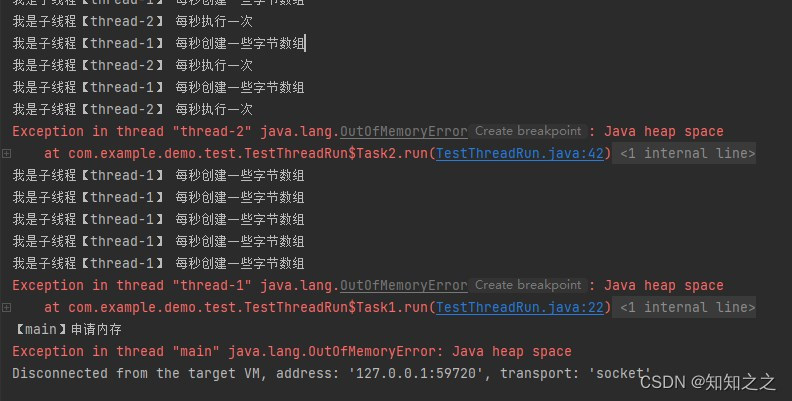程序是否退出和发生 OOM 无关
需要明确,程序是否退出和发生 OOM 无关,而和当前是否还有存活的非守护线程有关。
只要还有运行中的子线程,即使 main 线程结束或异常崩溃了,程序也不会停止。
public class TestThreadRun {private static class MyTask implements Runnable {@Overridepublic void run() {while (true) {System.out.println(String.format("我是子线程【%s】 每秒执行一次", Thread.currentThread().getName()));try {TimeUnit.SECONDS.sleep(1);} catch (InterruptedException e) {e.printStackTrace();}}}}public static void main(String[] args) {Thread thread = new Thread(new MyTask(), "sub-thread-1");
// thread.setDaemon(true);thread.start();System.out.println("main 线程结束");throw new RuntimeException("抛个异常");}
}
发生 OOM 时线程及其持有资源发生什么
当线程创建对象时,如果内存不足,会进行 GC,若GC 后还是内存不足,JVM 就会抛出OutOfMemoryError,如果线程没有处理异常,异常会继续向外层抛出,kill 掉线程,线程本身和其持有的资源就可以被回收了。
OOM 异常只会导致当前线程结束,对其他线程无影响。
后续其他线程再申请内存空间时,可能由于空间不足会发起 GC,然后就能够回收掉被关闭的线程和相关资源。
但是,线程被 kill 掉后,线程持有的资源只是可以被回收了,并不是一定能够回收,如果这些资源被其他线程持有,或者是一些全局变量、静态变量等不容易被 GC 的对象,那么堆内存空间占用依然会比较高。
这时候,其他线程再申请内存时,会继续发生 OOM 直至所有线程都结束,程序退出。
资源可以被回收的情况
public class TestThreadOOM {private static class Task1 implements Runnable {List<byte[]> list = new ArrayList<>(); // 资源与线程绑定@Overridepublic void run() {while (true) {System.out.println(String.format("我是子线程【%s】 每秒创建一些字节数组", Thread.currentThread().getName()));list.add(new byte[1024*1024*5]);try {TimeUnit.SECONDS.sleep(1);} catch (InterruptedException e) {e.printStackTrace();}}}}private static class Task2 implements Runnable {@Overridepublic void run() {while (true) {System.out.println(String.format("我是子线程【%s】 每秒执行一次", Thread.currentThread().getName()));try {TimeUnit.SECONDS.sleep(1);} catch (InterruptedException e) {e.printStackTrace();}}}}public static void main(String[] args) throws InterruptedException {Thread thread = new Thread(new Task1(), "thread-1");thread.start();Thread thread2 = new Thread(new Task2(), "thread-2");thread2.start();thread.join();thread2.join();System.out.println("main 线程结束");}
}
资源回收不了的情况
代码和上面差不多,只是 List 调整为静态变量
public class TestThreadOOM {static List<byte[]> list = new ArrayList<>(); // 使用静态变量 不会被回收private static class Task1 implements Runnable {@Overridepublic void run() {while (true) {System.out.println(String.format("我是子线程【%s】 每秒创建一些字节数组", Thread.currentThread().getName()));list.add(new byte[1024*1024*5]);try {TimeUnit.SECONDS.sleep(1);} catch (InterruptedException e) {e.printStackTrace();}}}}private static class Task2 implements Runnable {private AtomicInteger i = new AtomicInteger(0);@Overridepublic void run() {while (true) {System.out.println(String.format("我是子线程【%s】 每秒执行一次", Thread.currentThread().getName()));if (i.getAndIncrement() >= 10) { // 确保线程1 oom了byte[] buf = new byte[1024*1024 * 20]; // 申请一些内存}try {TimeUnit.SECONDS.sleep(1);} catch (InterruptedException e) {e.printStackTrace();}}}}public static void main(String[] args) throws InterruptedException {Thread thread = new Thread(new Task1(), "thread-1");thread.start();Thread thread2 = new Thread(new Task2(), "thread-2");thread2.start();thread.join();thread2.join();try {TimeUnit.SECONDS.sleep(2);} catch (InterruptedException e) {e.printStackTrace();}System.out.println(String.format("【%s】申请内存", Thread.currentThread().getName()));byte[] buf = new byte[1024*1024 * 20]; // 申请一些内存System.out.println("main 线程结束");}
} 

)
)
)



:开发板烧写ubuntu固件(支持mipi屏镜像+支持hdmi屏镜像))

)



)
)




